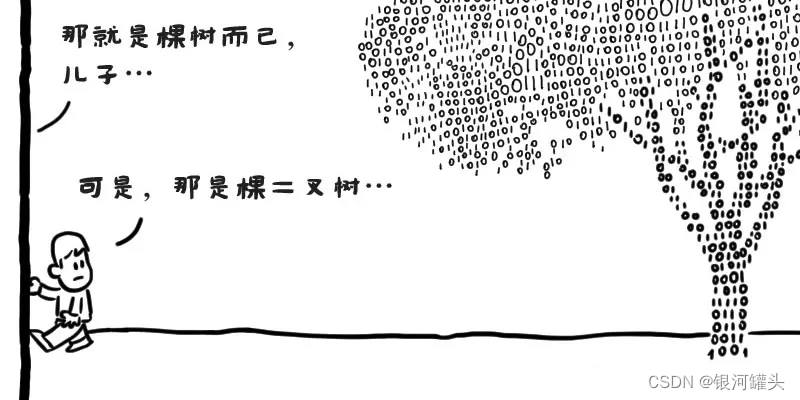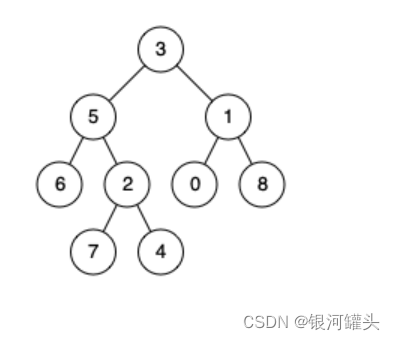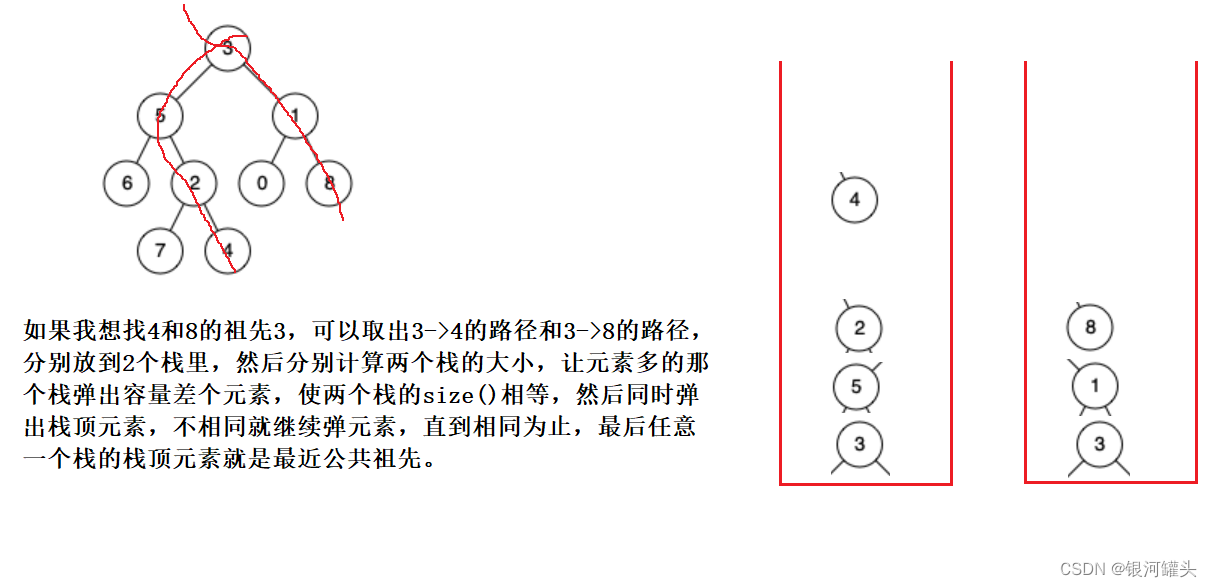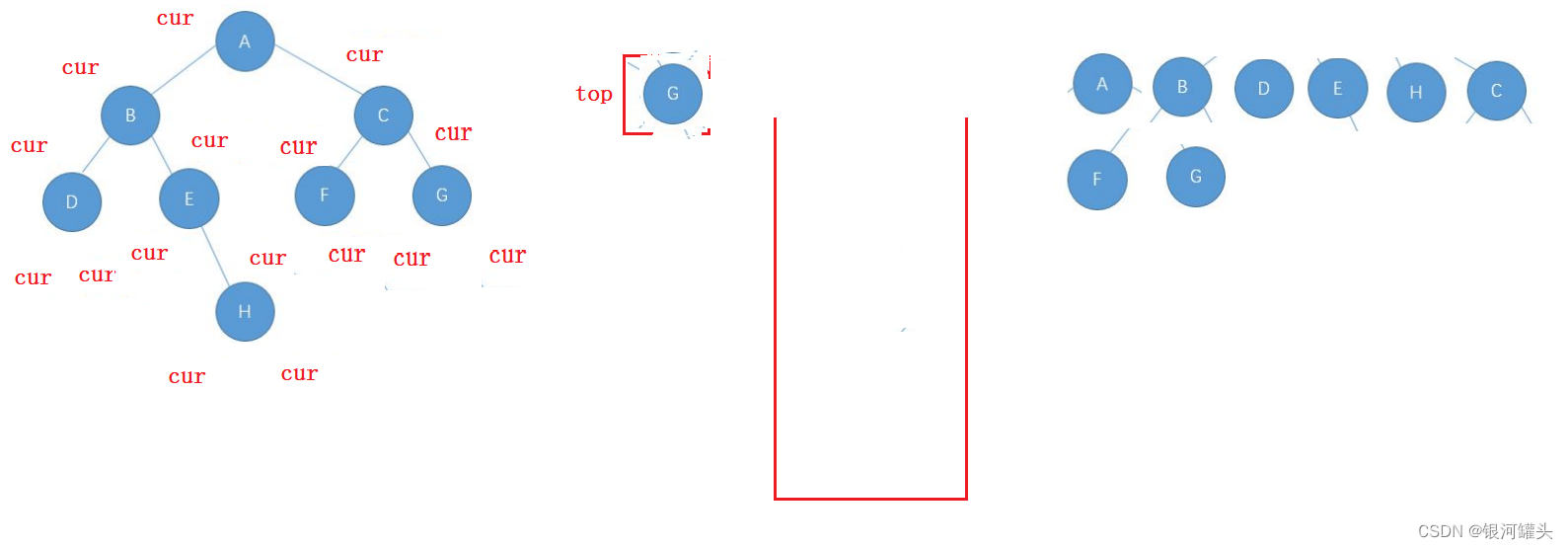
KY11 二叉树遍历
编一个程序,读入用户输入的一串先序遍历字符串,根据此字符串建立一个二叉树(以指针方式存储)。 例如如下的先序遍历字符串: ABC##DE#G##F### 其中“#”表示的是空格,空格字符代表空树。建立起此二叉树以后,再对二叉树进行中序遍历,输出遍历结果。
示例1
输入:
abc##de#g##f###
输出:
c b e g d f a

import java.util.Scanner;
// 注意类名必须为 Main, 不要有任何 package xxx 信息
class TreeNode{
public char val;
public TreeNode left;
public TreeNode right;
public TreeNode(char val){
this.val=val;
}
}
public class Main {
public static void main(String[] args) {
Scanner in = new Scanner(System.in);
// 注意 hasNext 和 hasNextLine 的区别
while (in.hasNextLine()) {
// 注意 while 处理多个 case
String str=in.nextLine();
TreeNode root=createTree(str);
inorder(root);
}
}
//中序遍历
public static void inorder(TreeNode root){
if(root==null){
return;
}
inorder(root.left);
System.out.print(root.val+" ");
inorder(root.right);
}
public static int i=0;
//全局,i只有一份
public static TreeNode createTree(String str){
TreeNode root=null;
char ch=str.charAt(i);
if(ch!='#'){
//遍历字符串,如果是字符,就new一个结点,然后左边和右边递归
root=new TreeNode(ch);
i++;
root.left=createTree(str);
root.right=createTree(str);
}else{
//如果是‘#’,说明走到空的位置,就i++,继续遍历字符串,同时返回root的初始值null,返回到上一次递归
i++;
}
return root;
}
}
力扣236.二叉树的最近公共祖先

示例 1:
输入:root = [3,5,1,6,2,0,8,null,null,7,4], p = 5, q = 1
输出:3
解释:节点 5 和节点 1 的最近公共祖先是节点 3 。
方法一
借助栈
可以联想到两个链表的公共节点问题

那么如何找到两个元素的路径?
先创建一个栈,把root入栈,如果root==p,返回true回到上一次递归,否则就到root.left去找,没找到就去root.right找,都没找到就弹出栈顶元素,返回false
import java.util.Stack;
public class Solution {
class TreeNode{
public char val;
public TreeNode left;
public TreeNode right;
public TreeNode(char val){
this.val=val;
}
}
//方法1,借助栈
public TreeNode lowestCommonAncestor(TreeNode root, TreeNode p, TreeNode q) {
if(root==null||p==null||q==null){
return null;
}
Stack<TreeNode> stack1=new Stack<>();
getPath(root,p,stack1);
Stack<TreeNode> stack2=new Stack<>();
getPath(root,q,stack2);
int size1=stack1.size();
int size2=stack2.size();
int size=0;
if(size1>size2){
size=size1-size2;
for(int i=0;i<size;i++){
stack1.pop();
}
}else{
size=size2-size1;
for(int i=0;i<size;i++){
stack2.pop();
}
}
while(stack1.peek()!=stack2.peek()){
stack1.pop();
stack2.pop();
}
return stack1.peek();
}
public boolean getPath(TreeNode root,TreeNode node,Stack<TreeNode> stack){
if(root==null||node==null){
return false;
}
stack.push(root);
if(root==node){
return true;
}
boolean ret1=getPath(root.left,node,stack);
if(ret1==true){
return true;
}
boolean ret2=getPath(root.right,node,stack);
if(ret2==true){
return true;
}
stack.pop();
return false;
}
方法二

class Solution {
public TreeNode lowestCommonAncestor(TreeNode root, TreeNode p, TreeNode q) {
if(root==null){
return null;
}
if(root==p||root==q){
return root;
}
TreeNode leftTree=lowestCommonAncestor(root.left,p,q);
TreeNode rightTree=lowestCommonAncestor(root.right,p,q);
if(leftTree!=null&&rightTree!=null){
//两侧
return root;
}
else if(leftTree!=null){
//都在左边
return leftTree;
}
else if(rightTree!=null){
//都在右边
return rightTree;
}
else{
return null;
}
}
}
牛客JZ36 二叉搜索树与双向链表
输入一棵二叉搜索树,将该二叉搜索树转换成一个排序的双向链表。
要求不能创建任何新的结点,只能调整树中结点指针的指向。返回链表中的第一个节点的指针
二叉搜索树:
根节点的左边都比根节点小,根节点的右边都比根节点大。
特点:中序遍历是有序的

在中序遍历递归的基础上做修改,使结点的left,right指向改变,最后返回root=8,题目要求返回链表第一个节点的指针,所以从8开始往左找,找到left=null的节点1即为链表的头结点
public class Solution {
TreeNode prev = null;
public TreeNode Convert(TreeNode pRootOfTree) {
if (pRootOfTree == null) {
return null;
}
ConvertChild(pRootOfTree);
TreeNode head = pRootOfTree;
while (head.left != null) {
head = head.left;
}
return head;
}
public void ConvertChild(TreeNode pCur) {
if (pCur == null) {
return;
}
ConvertChild(pCur.left);
pCur.left = prev;
if (prev != null) {
prev.right = pCur;
}
prev = pCur;
ConvertChild(pCur.right);
}
}
//迭代+递归修改指向
力扣144.二叉树前序非递归遍历实现
借助栈
cur指向root,cur不为空,把cur进栈,并且list.add(),然后cur往左走,如果cur走到空,栈弹出栈顶元素赋给top,cur指向top.right,如果栈弹空了,说明遍历结束

import java.util.ArrayList;
import java.util.List;
import java.util.Stack;
class TreeNode {
int val;
TreeNode left;
TreeNode right;
TreeNode() {
}
TreeNode(int val) {
this.val = val;
}
TreeNode(int val, TreeNode left, TreeNode right) {
this.val = val;
this.left = left;
this.right = right;
}
}
public class Solution {
public List<Integer> preorderTraversal(TreeNode root) {
List<Integer> list = new ArrayList<>();
TreeNode cur = root;
Stack<TreeNode> stack = new Stack<>();
while (true) {
if (cur != null) {
stack.push(cur);
list.add(cur.val);
cur = cur.left;
}
//cur为空
else {
if (stack.isEmpty()) {
break;
}
TreeNode top = stack.pop();
cur = top.right;
}
}
return list;
}
}